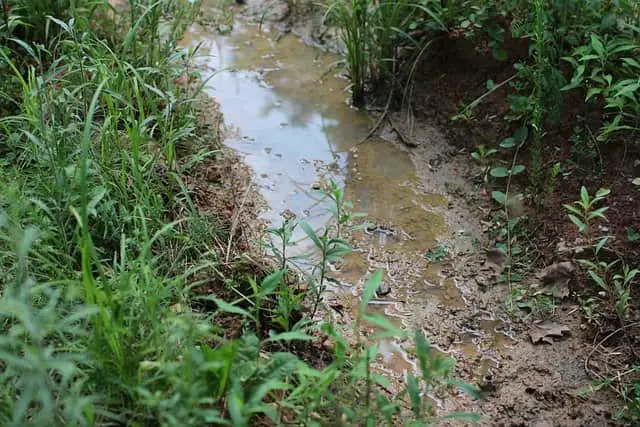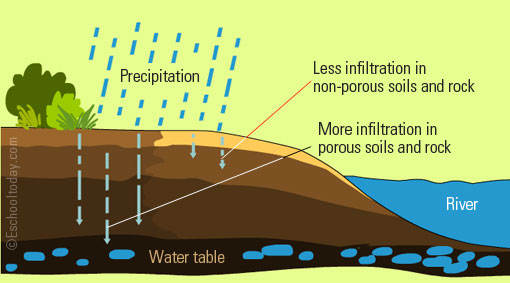INFILTRATION – Meaning, Process, and Infiltration rates
Compiled by Stanley Udegbunam || Nov 11, 2020
Table of Content
AFRILCATE
WHAT IS INFILTRATION?
Infiltration is the downward movement of water into the soil.
The surface phenomenon is governed by soil surface conditions.
If the precipitation rate exceeds the infiltration rate, surface runoff will occur unless there are some physical barriers.
Infiltration is very similar to percolation since they both involve downward water entry.
One major thing to note is that percolation can only occur after water infiltrated the soil surface.
INFILTRATION PROCESS
When rain or snowmelt hits the ground, It may either infiltrate the soil or continue across the land as runoff.
Others may remain in ground ruts or depressions before infiltrating or evaporating.
Infiltration occurs when precipitation or surface water penetrates the soil surface.
Infiltration process is similar to pouring water on a cut-out foam.
The foam soaks up the water until it can hold no more.
Any additional water poured will flow from the sides.
Infiltration is governed by two forces:
- gravity and
- capillary action.
Water moves more quickly through the large pores of sandy soil as a result of capillary action compared to its slow movement through smaller pores in clayey soil.
Small pores offer greater resistance to gravity.
The maximum amount of rainwater that can enter a soil in a given time is called the soil’s infiltration capacity.
When this maximum is reached, the soil becomes saturated.
Similar to the foam, the excess water in the soil will overflow in the form of runoff, which is surface water flowing over land.
Much of the water held in saturated soil is available for uptake by growing plants.
The plant at this level will have more than enough water to replace those lost to the atmosphere by transpiration.

what does infiltration mean in the water cycle?
Infiltration capacity is influenced by the soil type, structure, and moisture content at the start of the rain.
Confused about the word “runoff”?
See our comprehensive article here: surface water runoff
INFILTRATION RATE
Infiltration rate is a measure of the rate at which a particular soil is able to absorb water.
Just like how fast a foam can absorb water depends on the type of foam, infiltration into the soil depends on the characteristics of that soil.
After the precipitate (rain, snowballs) hits the earth’s surface, the rate of soil infiltration is determined by two major factors:
- Porosity of the soil
- Permeability of the soil
A soil is said to be porous when it has coarse particles with large pores.
Porosity is all about the size, shape, and packing of soil particles.
A more porous soil will lose its water content quickly to gravity.
The very small spaces of micro-pores are not as affected by gravity hence they retain water and nutrients longer.
Additionally, the more the porosity, the faster the infiltration rate.

Infiltration rates in porous and non-porous soil
A soil may be porous but not permeable.
Permeability is a measure of the ease with which a fluid (water in this case) can move through porous rock.
It refers to how connected these pore spaces are to one another.
If the material has high permeability then pore spaces are connected to one another.
This allows for the smooth flow of water across different soil paths.
However, if there is low permeability, then the pore spaces are isolated and water is trapped within them.
For instance, in gravel, all the pores are well connected to one another allowing water to flow through easily, but in clay most of the pore spaces are blocked.
This makes water flow much more difficult in clay.

A more connected pores will lead to higher permeability.
Infiltration is at its peak when the soil surface is both porous and permeable. (awesome right?)
A defect in one of these factors (porosity or permeability) will hinder water from recharging the aquifer at the rate expected.
This will eventually lead to shortage of groundwater after a long period of time.
In such scenario, there are two known ways of rectifying this defect.
1. You can either mix the soil with organic matter (causes soil to form aggregate) or
2. through artificial recharge.
Soil porosity and permeability are important measurements in areas where drinking water is provided by groundwater reserves.
As the soil moves towards saturation, the infiltration capacity tends to be reached and the infiltration rate decreases.
Infiltration rate is measured in inches per hour or millimeters per hour.
Runoff happens readily with poorly managed soils because they lack strong aggregates that hold against the force of raindrops and moving water.
Such runoff can initiate erosion, with losses of nutrients and sediments.
Generally, the rate of infiltration depends on factors such as:
- the amount of precipitation,
- the type of soils,
- the amount of vegetative cover over the area,
- pre-saturation levels,
- the topography of the land,
- the levels of evapotranspiration in that region.
Poor soil management reduces infiltration rate and makes it difficult for water to penetrate the soil.
Do you want to know how best to improve the infiltration rate of soil?
see this article: 5 Best ways to improve imfiltration rate
INFILTRATION AND WATER CYCLE
Infiltration is a part of the water cycle. Once infiltrated, it becomes groundwater.
Depending on how saturated the ground is, the water can continue downwards to replenish water tables and aquifers. This is called percolation.
If there are water bodies nearby, the infiltrated water can seep into it where it’s lost back to the atmosphere through evaporation.
They are various factors that affect the infiltration rate of soils.
Not to worry, we have curated an article that talks about the: 7 major factors affecting infiltration
DO YOU KNOW?
The study of water movement on and beneath the earth’s surface is called hydrology.
DO YOU KNOW?
The study of water movement on and beneath the earth’s surface is called hydrology.


Trackbacks/Pingbacks